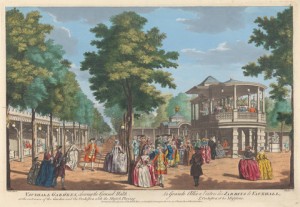
Vauxhall Gardens shewing the Grand Walk at the Entrance of the Garden and the Orchestra with the Music Playing. John S. Muller, ca. 1715-1792, German, active in Britain; after Samuel Wale, 1721-1786, British. After 1751. Yale Center for British Art, Paul Mellon Collection.
The English garden will be in the spotlight this year as the Royal Horticultural Society (RHS) Chelsea Flower Show (May 21-25) marks its 100th anniversary. Arguably the most famous and most prestigious garden show in not only England but the world, the RHS Chelsea Flower Show has been held on the grounds of the Chelsea Hospital every year since its launch in 1913, except during the war years. Although the Chelsea Flower Show might seem like a modern attraction, gardens and parks have long been popular forms of entertainment in England. In fact, the Chelsea Flower Show takes place on what was once Ranelagh Gardens, one of several famous 18th-century pleasure gardens located on the outskirts of London.
In many ways, pleasure gardens were the amusement parks of Georgian England, allowing visitors to escape the hustle and bustle of city life while offering them a variety of entertainment, including picturesque gardens, strolling paths, musical concerts, al fresco dining, balloon rides, waterfalls, fountain displays, masquerades, balls, and even fireworks shows. Basically, there existed an attraction for almost everyone of every taste, not least important among them being the chance to see and be seen by members of London high society.
Vauxhall, open from 1661 to 1859, is considered the first and most popular of the pleasure gardens because of the variety of entertainment it offered as well as the large crowd it always attracted (due in large part to its low entrance fee of only a shilling). Due to its lack of exclusivity, Vauxhall also became a prime example of some of the problems that existed for most pleasure gardens: Vauxhall’s “dark walks” (unlit paths) were popular hideouts for young lovers as well as pickpockets, rapists, prostitutes, and other criminals, making the garden a sometimes dangerous and undesirable place to visit at night. Vauxhall’s “dark walks” were so infamous that they were commonly referenced in popular literature at the time, a prime example being Frances Burney’s novel Evelina, in which they are the setting for the heroine’s near-rape experience. But, despite its seedy underbelly, Vauxhall was only ever really rivaled by the more exclusive Ranelagh, which opened in 1746 and was particularly popular among the higher classes. Pleasure gardens became such a popular London attraction that they remained in fashion through the Victorian era and were recreated in other cities and even other countries. The following is a list of some interesting websites and recent scholarship related to 18th-century pleasure gardens:
- The Museum of London website includes a “pocket history” of Vauxhall, entitled “What were Vauxhall Pleasure Gardens like,” that provides information on the gardens’ opening, closing, and daily activities in-between.
- A group of students at the University of Michigan have made a website about entertainment in 18th-century Britain that includes a page on “Pleasure Gardens and Tea Rooms.”
- Sarah Jane Downing’s book The English Pleasure Garden: 1660-1680 provides a history of the English pleasure gardens, including their creation, their rise in popularity, their use of various entertainments, and their decline into hideaways for London degenerates.
- Jonathan Conlin studies the progression from the first pleasure gardens of the 17th century to the amusement parks of the 20th century in his book The Pleasure Garden, from Vauxhall to Coney Island, which focuses on the affect of architecture, design, music, and lighting on visitors.
- In their book Vauxhall Gardens a History, David Coke and Alan Borg provide a detailed history of the music, entertainments, artwork, social events, and interesting people that were always to be found at Vauxhall, that helped make it such a popular destination, and that influenced art and entertainment for years to come.

An excellent list- many thanks for sharing it. If you’re of the “one-picture-is-worth-a-thousand-words” school, you might also enjoy a Pinterest board I’ve put together for 18th & 19th c. London Pleasure Gardens. Lots of images from a variety of places – and all linked back to the original source as well. http://pinterest.com/2nerdyhistgirls/london-s-18th-19th-c-pleasure-gardens/